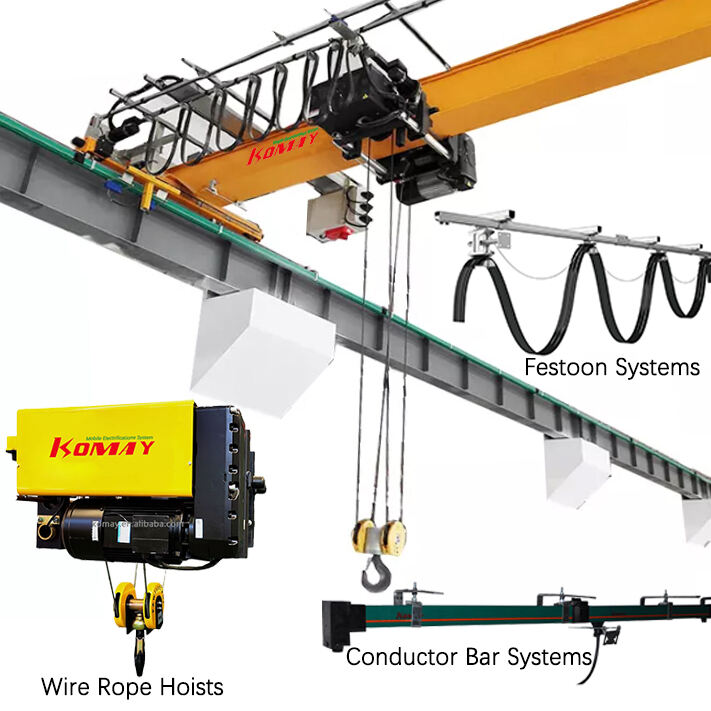Kurşunlar, bir yere başka bir yerden ağır herhangi bir şeyi kaldırmak ve taşımak için kullanılan makinelerdir. Sıralar ve yapı faaliyetlerindeki binanın yükselişi sırasında kullanılır, fabrikalarda onlardan yapılan ürünlerle de karşılaşırsınız ve aynı zamanda ticari doklara mallarla dolu gelen gemilerde de bulunurlar. Doğru şekilde ve verimli bir şekilde çalışabilmeleri için, kesintisiz bir enerji kaynağına ihtiyaç duyarlar. Peki, nasıl kurşunları güçlendirir ve bataryayı reddederiz? Buldukları çözüm, conductor rails (iletken raylar) olarak bilinen benzersiz bir sistemdir!
Iletken raylı kurşunlar nasıl çalışır?
Zemin seviyesinde bir hattı ray montaj sistemiyle çalışan bir kafes cran. Bu, cran her ne zaman ihtiyaç duyarsa enerji beslemesini sağlayacak şekilde canlı bir elektrik kaynağına bağlıdır. Enerji, pantograf adı verilen bir parçasıyla raydan crana aktarılır. Bu açıdan, pantografi, ray (kaynak) ile cranın motoru (orta gerilim yükünü tanımlayan) arasında iki iletken noktası köprüsü olarak düşünebiliriz. Cranın aşağı ve yukarı ilerlemesi için ve ağırlıklı malzemelerin belirlenmiş yerlere alınması veya bırakılması için özel yönlere hareket etmesi için gerekli olan gücü de bu şekilde sağlarız.
Nasıl Kullanılır Iletken Ray Cran_temel_detaylı_adımlar
Iletken ray cranelerin avantajlarından biri, doğru beslenirlerse her zaman çalışır durumda olmalarıdır. Enerji beslemesi olduğunda, büyük nesneyi hızlıca güvenle taşıyabilecek birisi elde edebilirsiniz. Bu durumda, cran raya bağlı kalır ve elektriğin sürekli beslenmesi sağlanırsa 24/7 çalışabilir.
Raylı kran operatörü, motorun nasıl çalıştırılacağını ve enerji sistemini bilmelidir. Bir arabanın şoför koltuğu gibi, aynı şekilde kranı kabininden kontrol eder ve manevra yapar. Operatörün her an önündeki veya bitişine doğru olanları açıkça görebildiği bu kabin, ayrıca operatörün kabininden CRM'yi istediği yere taşımak için kullanabileceği joysticks, düğmelerden başka birçok farklı basset kontrollerine de sahiptir.
Kranların İyi Çalışmasını Sağlama
Farklı türde pek çok kran bulabilirsiniz; ancak daha önce duymadığınız bir türü olan mal sadeleştirme kranıdır. Bir kranın hareketi ve kaldırma gücü, aldığı güce büyük ölçüde bağlıdır. Güç yetersizse veya düzgün çalışmadığı takdirde, belirli şeylerin bir yerden diğerine alınmasında sorunlar ortaya çıkacaktır. Bu nedenle, güvenilir bir raylı iletken sistemi gereklidir. Böylece kran sürekli bir enerji kaynağına sahip olur ve düzenli işlevsel çalışmayı sağlar.
Iletken rayları hala yerde, ancak kablolarla çalışan kollar yerine elektrik alıcıları ile sürdürülebilir veya sadece toplanabilir ve rayda kayarak hareket edebilir. Elektrik alıcı rayı dokunur ve onunla elektrik bağlantısı oluşturur, bu da güç aktarımını kazara aktive eder. Bu bağlantı, iş akışının kesintisiz olarak devam etmesi için sürekli iyi bir şekilde çalışması açısından çok önemlidir.
Kol Operasyonunu Daha Kolay Hale Getirme
Bu nedenle, kolların basit ve etkili bir şekilde çalışabilmesi için iletken raylar artık vazgeçilemez olmuştur - bu da çeşitli durumlarda bulunulabilecek bir gereklilik sayılır. Böylece operatör, bir gün için ne kadar batarya yapabileceği veya yakıt kullanabileceği konusunda düşünmeye gerek duymaz. Diğer taraftan, bu parçaların avantajı, bu kolların sürekli bir güç kaynağı olmasıdır, bu nedenle herhangi bir ağır malzeme kolayca kaldırılabilir ve taşınabilir.
Yani bir özete göre, kranlar kran şeridi rayları tarafından hareket etmeye desteklenir ve onların bir şey yapmalarını sağlar. Şeritli Ray Kranları: Şeritli ray kranları ise, ana hatla bağlantılı bir dizi raydan çekilen elektrikten yararlanır. Kran motor hareketleri, enerji eleştiren genişlik tabanlıdır. Benzer şekilde, şeritli ray kranları enerji verimlidir ve bu, belirli çevresel koşullar arasında toplu nesneleri kaldırırken daha fazla yapısal bütünlüğe dönüşür ki bu da daha büyük güvenilirlilik anlamına gelir. Bu kranlar, işçilerin görevleri en üst düzey güvende tamamlamasını sağlayarak sürekli enerji sağlar.

 EN
EN
 AR
AR
 HR
HR
 CS
CS
 DA
DA
 NL
NL
 FI
FI
 FR
FR
 DE
DE
 EL
EL
 HI
HI
 IT
IT
 JA
JA
 KO
KO
 NO
NO
 PL
PL
 PT
PT
 RO
RO
 RU
RU
 ES
ES
 SV
SV
 TL
TL
 IW
IW
 ID
ID
 LV
LV
 LT
LT
 SR
SR
 SK
SK
 UK
UK
 VI
VI
 SQ
SQ
 HU
HU
 TH
TH
 TR
TR
 AF
AF
 MS
MS
 BN
BN
 MN
MN
 KK
KK
 KY
KY
